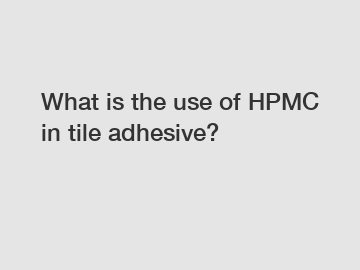Dec. 19, 2023
Chemicals
What is the use of HPMC in tile adhesive?
Tile adhesive plays a crucial role in ensuring strong and durable adhesion of tiles to various surfaces. One key ingredient that enhances the performance of tile adhesives is Hydroxypropyl Methylcellulose, commonly known as HPMC. But what exactly is the use of HPMC in tile adhesive? Let's delve deeper into its benefits and understand why it is an integral component in this construction material.
HPMC, a cellulose ether, is derived from natural polymers and is widely used in various industries due to its unique properties. In the context of tile adhesive, HPMC serves multiple purposes, including:

1. Improved Workability:
One primary function of HPMC in tile adhesive is to enhance the workability of the mixture. It acts as a thickening agent, providing better open time and allowing for a smoother application. As a result, the adhesive spreads evenly across the surface, reducing the chance of uneven tile installation. The improved workability provided by HPMC ensures ease of use for both professionals and DIY enthusiasts.
2. Increased Adhesive Strength:
Tile adhesives with HPMC benefit from increased adhesive strength. HPMC acts as a binder, effectively bonding the adhesive to the substrate and the tile itself. This strong bond prevents tiles from loosening or detaching over time, ensuring long-lasting adhesion. This is especially crucial in high-traffic areas or environments with temperature variations, where the adhesive needs to withstand frequent stress and strain.
3. Crack Resistance:
Cracks can be a significant concern when installing tiles, particularly in areas prone to movement or settling. HPMC helps reduce the risk of cracking by improving the flexibility and elasticity of tile adhesives. By adding HPMC to the mix, adhesives become more resilient, allowing them to absorb and distribute stress more evenly. This added flexibility reduces the likelihood of cracks forming, thus providing a more durable tile installation.
4. Water Retention:
HPMC is hygroscopic, meaning it has the ability to absorb and retain water. In tile adhesive, this property is beneficial for reducing the drying time and enhancing the adhesive's overall performance. The controlled water release provided by HPMC allows the adhesive to cure properly and form a strong bond with the tile and substrate. Additionally, the prolonged open time enabled by water retention allows for easier adjustment of tile placement, ensuring precise alignment.
In conclusion, HPMC brings significant value to tile adhesive by improving workability, increasing adhesive strength, enhancing crack resistance, and providing water retention capabilities. These properties contribute to a more efficient and durable tile installation process. It is no wonder that HPMC has become an essential ingredient in the formulation of modern tile adhesives.
So, the next time you embark on a tiling project, remember the essential role of HPMC in ensuring the strong and long-lasting bond between your tiles and the chosen substrate. With its numerous benefits, HPMC continues to be a must-have component in the world of tile adhesives.
Contact us to discuss your requirements of gypsum retarders, gypsum retarders, gypsum retarders. Our experienced sales team can help you identify the options that best suit your needs.
Previous: What is Compostable? Eco-Friendly Breakdown to Tackle Google Users' Burning Questions!
Next: Ultimate Guide: HPMC 2910 - Unveiling the Key Benefits & Popular Applications
If you are interested in sending in a Guest Blogger Submission,welcome to write for us!
All Comments ( 0 )